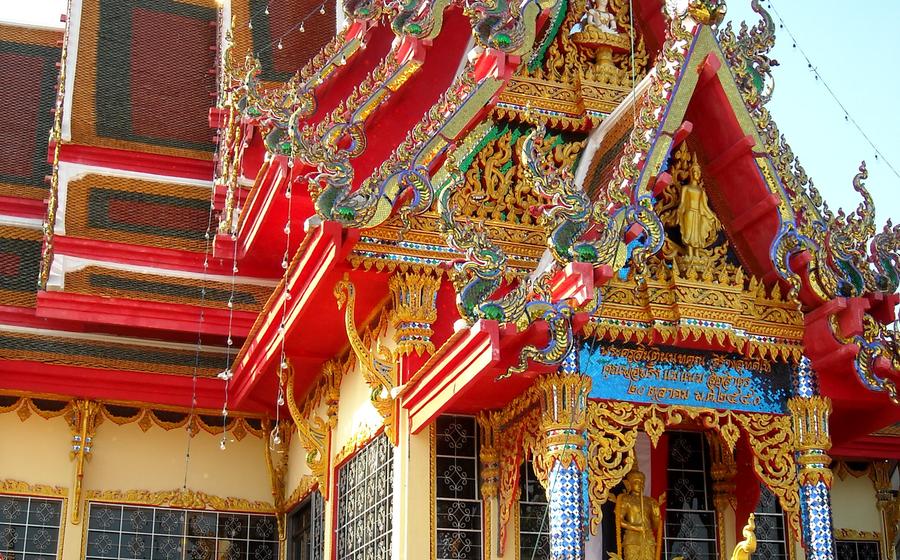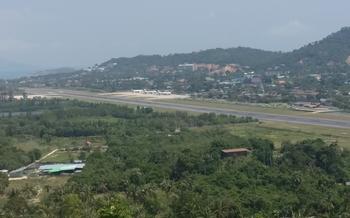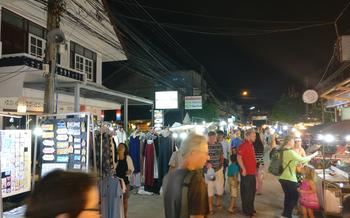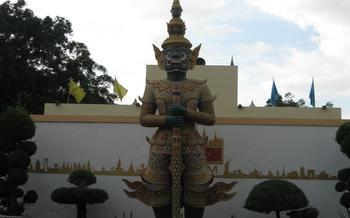
Wat Plai Laem
- The Wat Plai Laem: A Stunning Temple by the Sea
- Location and Getting There
- The Grand Pagoda: A Majestic Symbol
- The 18-Armed Guan Yin Statue: A Divine Presence
- The Ubosot: A Sacred Sanctuary
- The Ordination Hall: A Place of Transformation
- The Monk's Quarters: A Serene Retreat
- The Temple Fair: A Festive Celebration
- The Surrounding Area: Hidden Gems
- Photography Tips: Capturing the Beauty
- Respectful Attire and Behavior
- Local Cuisine: Tantalizing Flavors
- Insider Tip: Hidden Meditation Spot
The Wat Plai Laem: A Stunning Temple by the Sea
The Wat Plai Laem, also known as the Big Buddha Temple, is an awe-inspiring temple complex situated on the picturesque island of Ko Samui, Thailand. Steeped in history and religious significance, this temple stands as a testament to the island's rich cultural heritage.
Built in 1972 by a local monk named Phra Kru Samutrkoon, the Wat Plai Laem holds a special place in the hearts of both locals and visitors alike. Its prime location, perched atop a small hill overlooking the shimmering waters of the Gulf of Thailand, offers breathtaking panoramic views that will leave you spellbound.
The temple's striking architectural features, characterized by intricate carvings, colorful mosaics, and towering spires, showcase the essence of traditional Thai craftsmanship. As you step through the ornate gates, you'll be greeted by a serene and spiritual atmosphere that instantly transports you to a realm of tranquility and devotion.
Location and Getting There
The Wat Plai Laem is situated on the north coast of Ko Samui, approximately 15 kilometers from the island's main town, Nathon. To reach the temple, visitors can take a taxi or rent a motorbike from Nathon or other nearby areas. The journey takes about 30 minutes by taxi and 45 minutes by motorbike.
For those arriving from Bangkok or other major cities in Thailand, the most convenient option is to fly to Ko Samui Airport (USM). From the airport, visitors can take a taxi or rent a car to reach the temple, which is about a 20-minute drive away.
To find the best route to the Wat Plai Laem, visitors can use a reliable navigation app or ask for directions from locals. It's worth noting that the roads on Ko Samui can be narrow and winding, so driving cautiously is recommended.
Insider Tip:
For those seeking a more scenic route, consider taking a ferry from Koh Phangan or Koh Tao to Ko Samui and then renting a motorbike to explore the island. This option allows visitors to enjoy the beautiful coastal views and experience the island's laid-back atmosphere.
The Grand Pagoda: A Majestic Symbol
The grand pagoda at Wat Plai Laem is an awe-inspiring sight, towering over the temple complex and symbolizing the path to enlightenment. Built in a traditional Thai style, the pagoda features intricate carvings and colorful tiles that depict Buddhist stories and legends. Its design is a blend of Thai and Chinese influences, reflecting the cultural diversity of the region.
The pagoda's most striking feature is its height, which offers panoramic views of the surrounding area. From the top, you can see the lush green hills, the glistening sea, and the neighboring islands. It's a breathtaking vista that will leave you in awe of the beauty of Ko Samui.
To reach the top of the pagoda, you can climb a series of steep steps. The climb is challenging but worth the effort, as the view from the top is simply unforgettable. Remember to bring your camera to capture the stunning scenery.
Personal anecdote:
During my visit to the temple, I was lucky enough to catch the sunset from the top of the pagoda. As the sun dipped below the horizon, the sky was painted in hues of orange, pink, and purple, creating a magical atmosphere. It was a moment of pure bliss, and I felt a sense of peace and tranquility that I'll never forget.
The 18-Armed Guan Yin Statue: A Divine Presence
The Wat Plai Laem is home to a magnificent 18-armed Guan Yin statue, a revered figure in Chinese Buddhism. Standing tall and radiating compassion, this statue is a testament to the temple's diverse cultural influences. Legend has it that Guan Yin, the Goddess of Mercy, possesses a thousand arms to reach out to those in need. Each of the 18 arms on this statue holds a different symbolic object, representing her boundless power and willingness to aid her devotees. Whether you're a Buddhist or simply seeking solace, this statue exudes a sense of tranquility and invites you to pause and reflect. Standing before it, I couldn't help but feel a sense of calm wash over me, as if the statue's benevolent presence was offering me a moment of peace amidst the vibrant energy of the temple grounds.
The Ubosot: A Sacred Sanctuary
The Ubosot, also known as the ordination hall, is the most sacred building within the Wat Plai Laem temple complex. It serves as a place of worship, meditation, and religious ceremonies for the monks and visitors alike. The Ubosot is a rectangular structure with a traditional Thai-style gable roof and intricate carvings adorning its exterior.
Inside, the Ubosot is adorned with beautiful murals and paintings that depict various scenes from the life of Buddha and his teachings. These murals are not only visually stunning but also hold deep religious and cultural significance, providing visitors with a glimpse into the rich history and beliefs of Buddhism.
To show respect and maintain decorum within the Ubosot, visitors are expected to remove their shoes before entering and refrain from talking or making loud noises. It is also considered appropriate to bow or wai (a traditional Thai gesture of respect) towards the Buddha images before entering the hall.
During my visit to the Wat Plai Laem, I was particularly captivated by the intricate details and vibrant colors of the murals within the Ubosot. Each mural seemed to tell a unique story, and I found myself spending a considerable amount of time admiring the artwork and contemplating its deeper meanings.
The Ordination Hall: A Place of Transformation
Within the temple complex, the Ordination Hall stands as a sacred space dedicated to the initiation of young men into the Buddhist monkhood. This significant ceremony, known as the upasampada, marks a profound transformation in the life of the individual, as they embark on a journey of spiritual devotion and service.
The Ordination Hall's architectural design reflects its solemn purpose. Constructed with intricate carvings and adorned with vibrant murals depicting scenes from the Buddha's life, the hall exudes an atmosphere of reverence and awe. Inside, the central ordination platform takes center stage, where aspiring monks kneel before the presiding abbots to receive their vows and blessings.
During my visit, I had the privilege of witnessing a moving ordination ceremony. As the young men, clad in white robes, prostrated themselves before the venerable monks, the air crackled with a palpable sense of spirituality. The chanting of sacred mantras filled the hall, creating an ethereal ambiance that transported me to a realm beyond the ordinary.
It was a humbling experience to witness the unwavering commitment and devotion of these individuals as they embraced their chosen path. The Ordination Hall, with its sacred aura and symbolic significance, serves as a testament to the enduring power of faith and the transformative nature of the Buddhist tradition.
The Monk's Quarters: A Serene Retreat
Tucked away from the bustling temple grounds, the monk's quarters offer a sanctuary of peace and tranquility. These simple yet elegant dwellings provide a glimpse into the daily lives of the monks who call Wat Plai Laem their home.
Architecturally, the monk's quarters are characterized by their simplicity and functionality. Constructed using natural materials such as wood and bamboo, the buildings blend harmoniously with the surrounding environment. The quarters typically consist of a main hall where the monks gather for meditation and prayers, as well as individual cells where they sleep and study.
Within the monk's quarters, a sense of serenity prevails. The monks move about their daily routines with a grace and tranquility that is both inspiring and contagious. Visitors are welcome to observe the monks' daily activities, such as chanting, meditation, and studying Buddhist scriptures. It's a unique opportunity to gain insights into the life of a Buddhist monk and the principles of the Buddhist faith.
When interacting with the monks, it's important to be respectful and mindful of their vows of silence and seclusion. A simple nod or wai (a traditional Thai greeting with hands pressed together in a prayer-like gesture) is often sufficient to acknowledge their presence. If you're fortunate, you may encounter a monk who is willing to share his wisdom and teachings, offering a rare glimpse into the profound teachings of Buddhism.
The Temple Fair: A Festive Celebration
Amidst the tranquility of Wat Plai Laem, the annual temple fair bursts forth as a vibrant spectacle of color, music, and community spirit. Typically held during the Thai New Year in April, this lively event transforms the temple grounds into a bustling marketplace, where locals and visitors alike come together to celebrate and embrace Thai culture.
From early morning till late evening, the air crackles with excitement as vendors set up their stalls, displaying an array of handmade crafts, traditional clothing, and local delicacies. The enticing aromas of grilled meats, sweet desserts, and tropical fruits waft through the air, tempting visitors to indulge in culinary delights.
As the sun begins its descent, the tempo of the fair rises, with live music performances echoing through the temple grounds. Local musicians showcase their talents, playing traditional Thai instruments and belting out soulful melodies that captivate the audience. The atmosphere becomes electric as people dance, sing, and immerse themselves in the infectious energy.
Don't miss the chance to experience the temple fair, an event that encapsulates the vibrant essence of Thai culture. Embrace the festive spirit, savor the local cuisine, and let the infectious energy of the fair sweep you away.
The Surrounding Area: Hidden Gems
Beyond the temple grounds, the surrounding area offers a wealth of hidden gems waiting to be explored. Just a short walk away, the bustling Lamai Night Market beckons with its vibrant atmosphere, offering a delectable array of local delicacies and souvenirs. Culinary enthusiasts can indulge in mouthwatering seafood and traditional Thai dishes, while shopaholics can browse the stalls for unique handicrafts and textiles.
Venture further afield to discover the idyllic Lamai Beach, a haven for water sports enthusiasts and sun-seekers alike. Bask in the warm embrace of the tropical sun, take a refreshing dip in the crystal-clear waters, or try your hand at exhilarating activities like snorkeling, kayaking, and stand-up paddleboarding.
Nature lovers will find solace in the lush greenery of the nearby Samui Butterfly Garden, home to a kaleidoscope of vibrant butterflies fluttering amidst tropical flowers. For a unique cultural experience, visit the Samui Elephant Sanctuary, where you can interact with these gentle giants in a responsible and ethical way.
To create a well-rounded itinerary, consider renting a motorbike or bicycle to explore the island at your own pace. Discover secluded coves, hidden waterfalls, and charming villages nestled amidst the verdant hills. With so much to see and do, you'll be spoilt for choice in Ko Samui.
Photography Tips: Capturing the Beauty
The Wat Plai Laem offers a wealth of photographic opportunities, from its stunning architecture to its serene natural surroundings. To capture the best shots, consider visiting during the golden hours of sunrise or sunset, when the light is soft and warm. Use a wide-angle lens to capture the temple's grandeur and the surrounding landscape. Experiment with different angles and perspectives to create dynamic compositions. Don't be afraid to get close to capture intricate details, or to step back to capture the temple's majesty against the backdrop of the sea. Remember to respect the sanctity of the temple and avoid disturbing visitors or monks during your photography session.
Respectful Attire and Behavior
As visitors to Wat Plai Laem, it's essential to demonstrate respect for the temple's sacred nature and the local culture. Appropriate attire is recommended, with shoulders and knees covered. Avoid wearing excessively revealing or casual clothing. When entering the temple grounds, remove your shoes and place them neatly on the designated racks.
Within the temple, maintain a respectful demeanor. Avoid loud conversations or boisterous behavior. Be mindful of your body language, ensuring that you don't point your feet towards Buddha images or monks. When seated, keep your feet flat on the floor and avoid crossing your legs.
Remember that the temple is an active place of worship for the local community. Be respectful of ceremonies or rituals taking place and avoid disrupting them. If you're unsure about any customs or traditions, don't hesitate to ask a local guide or staff member for guidance.
Once, I inadvertently committed a cultural faux pas by wearing shorts that were above my knees. A kind local approached me and politely explained the significance of dressing modestly in the temple. I immediately apologized and changed into more appropriate attire, grateful for the opportunity to learn and show respect for the local customs.
Local Cuisine: Tantalizing Flavors
Visiting Wat Plai Laem offers a unique opportunity to savor the vibrant flavors of Thai cuisine. The temple is surrounded by a plethora of local eateries, street food stalls, and restaurants, each offering a delectable array of dishes to tempt your taste buds. From spicy curries and fragrant noodle soups to refreshing salads and tropical fruits, the culinary scene near the temple is a feast for the senses.
For an authentic Thai experience, try the local markets, where you can find an assortment of fresh produce, meats, and spices. Here, you can sample delicious street food snacks like grilled skewers, crispy roti, and tangy papaya salad. For a more relaxed dining experience, visit one of the many restaurants in the area, where you can indulge in a variety of Thai dishes, from classic favorites like Pad Thai and Massaman curry to regional specialties and seafood platters.
If you're a vegetarian or vegan, you'll be pleased to find that there are several options available near the temple. Many restaurants offer meat-free versions of popular Thai dishes, using tofu, tempeh, or vegetables as protein sources. Be sure to try the flavorful green curry with tofu or the refreshing Som Tum, a spicy papaya salad made with peanuts and lime.
One of my favorite culinary discoveries near Wat Plai Laem was a hidden gem of a restaurant tucked away in a quiet alley. The unassuming eatery served up some of the most delicious and authentic Thai food I've ever tasted. The Massaman curry was rich and creamy, with tender chunks of beef that melted in my mouth. The Pad See Ew was perfectly balanced, with savory soy sauce, sweet tamarind, and fresh vegetables. I highly recommend seeking out this hidden gem for an unforgettable dining experience.
Insider Tip: Hidden Meditation Spot
Hidden amidst the lush gardens of Wat Plai Laem, you'll find a secluded meditation spot that offers a serene escape from the bustling crowds. Tucked away behind the main temple complex, this tranquil haven invites you to immerse yourself in peaceful contemplation and reflection.
As you step into the hidden spot, you'll be enveloped by a sense of tranquility. The gentle rustling of leaves in the breeze, the soft chirping of birds, and the distant sound of chanting monks create a harmonious symphony that soothes the soul. The air is fragrant with the scent of jasmine and frangipani blossoms, adding to the serene ambiance.
Find a comfortable spot beneath the shade of a bodhi tree, close your eyes, and let your mind wander freely. Allow the peaceful surroundings to wash away your worries and distractions. Focus on your breath, inhaling and exhaling slowly and deeply. As your mind settles, you may experience a sense of inner peace and tranquility.
The hidden meditation spot is a sanctuary for those seeking a moment of respite and reflection. Whether you're a seasoned meditator or simply looking for a peaceful place to unwind, this hidden gem is sure to leave you feeling refreshed and rejuvenated. Embrace the serenity of this special place and discover the transformative power of meditation.





